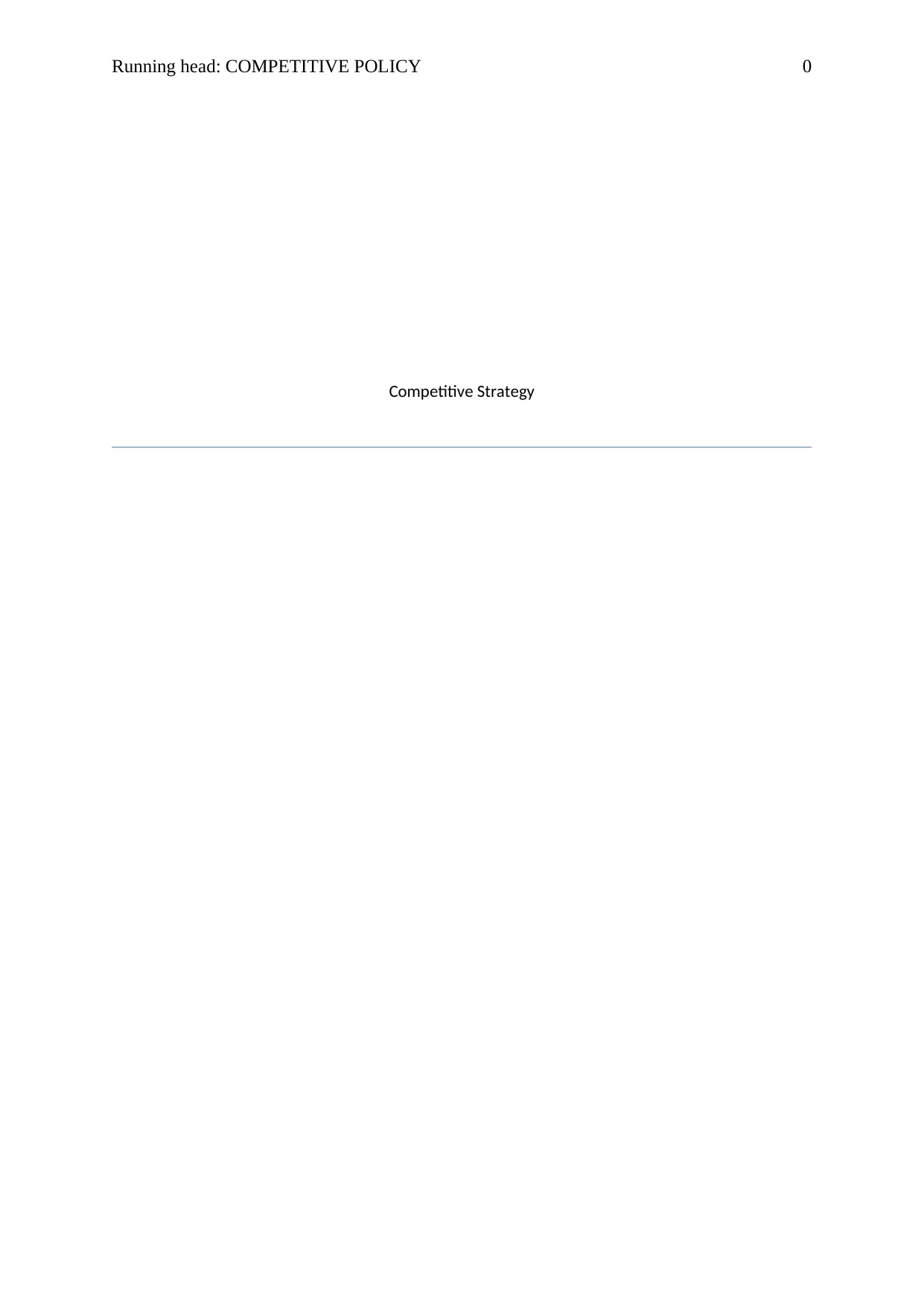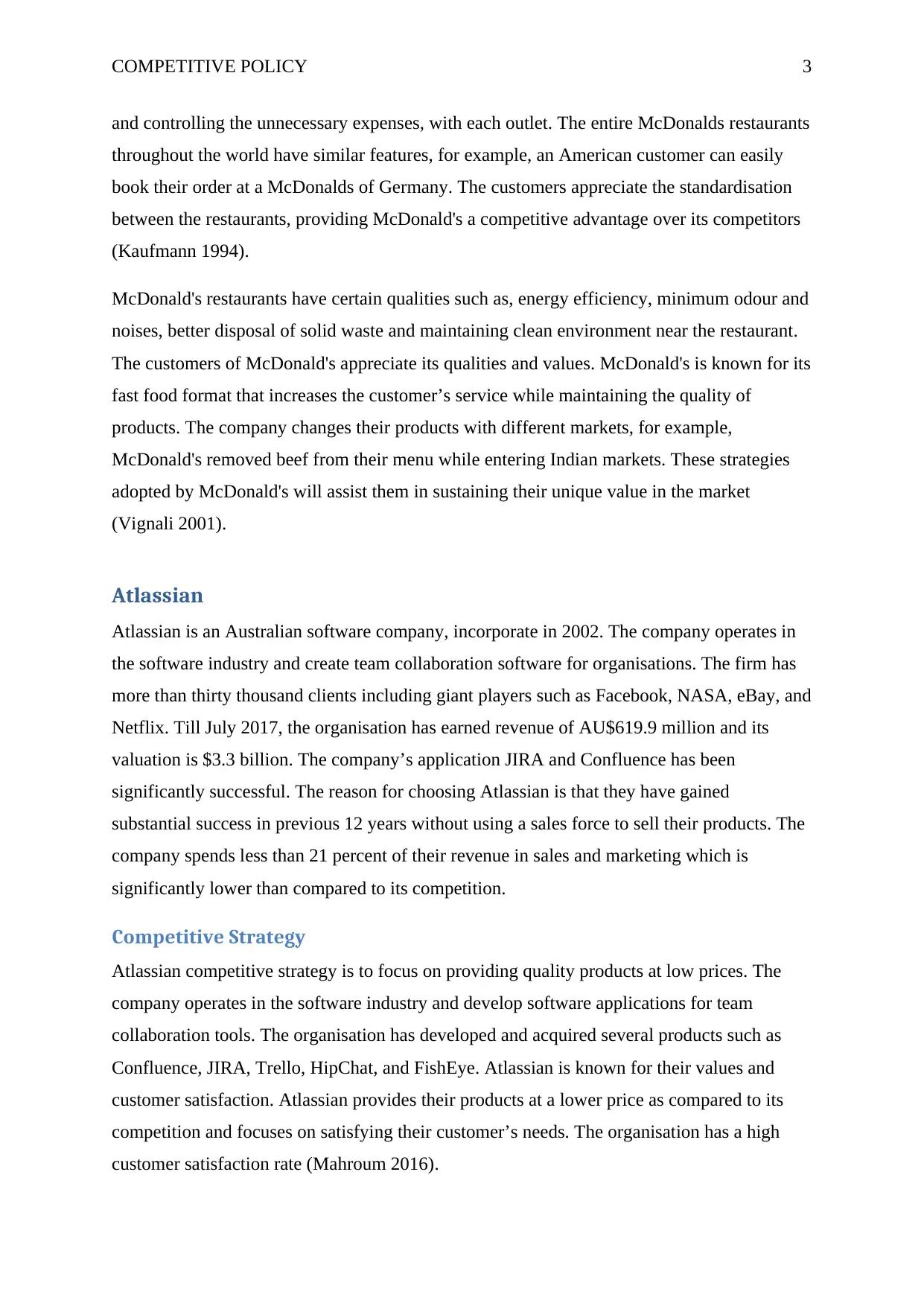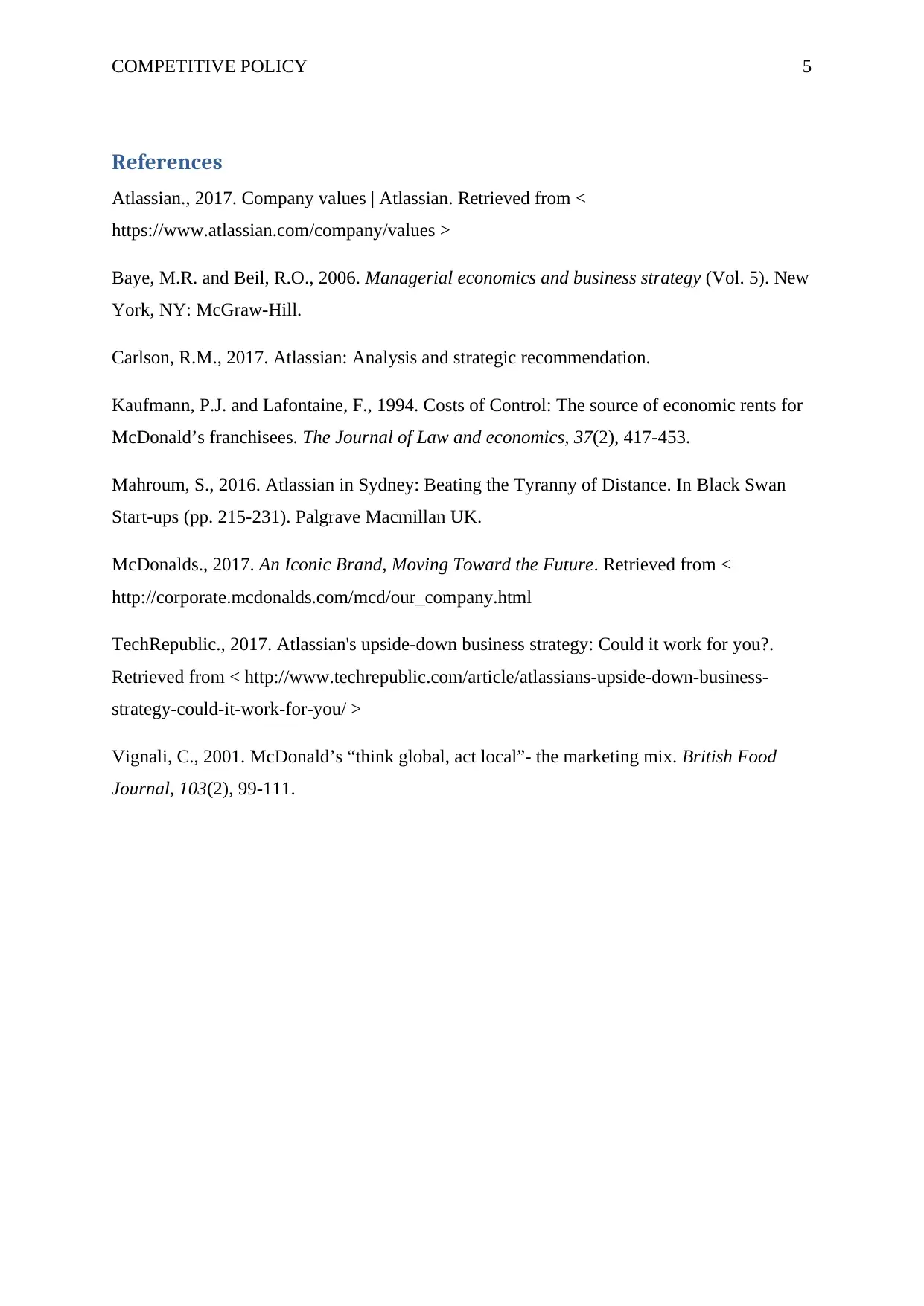Competitive Strategy Analysis: McDonald's and Atlassian Report
VerifiedAdded on 2020/03/04
|6
|1377
|164
Report
AI Summary
This report provides a detailed analysis of the competitive strategies employed by two distinct companies: McDonald's and Atlassian. The report begins with an overview of McDonald's, a global fast-food chain, examining its cost advantage through low prices, convenient locations, and efficient processes, as well as its 'three-legged stool' business model involving franchisees, suppliers, and employees. It highlights McDonald's focus on standardization, quality, and adaptation to local markets. The report then shifts to Atlassian, an Australian software company, exploring its differentiation advantage through quality products at low prices, its focus on customer satisfaction, and its unique business model that prioritizes product excellence and online availability. It also discusses Atlassian's upside-down strategy of minimizing sales and marketing expenses. The report concludes by summarizing the key strategies and competitive advantages of both companies, providing insights into their market positions and business models.

Running head: COMPETITIVE POLICY 0
Competitive Strategy
Competitive Strategy
Paraphrase This Document
Need a fresh take? Get an instant paraphrase of this document with our AI Paraphraser

COMPETITIVE POLICY 1
Table of Contents
McDonalds.................................................................................................................................2
Competitive Strategy..............................................................................................................2
Atlassian.....................................................................................................................................3
Competitive Strategy..............................................................................................................3
References..................................................................................................................................5
Table of Contents
McDonalds.................................................................................................................................2
Competitive Strategy..............................................................................................................2
Atlassian.....................................................................................................................................3
Competitive Strategy..............................................................................................................3
References..................................................................................................................................5

COMPETITIVE POLICY 2
McDonalds
McDonald's is a fast food restaurant chain incorporated in America. It was founded in 1940
as a barbecue restaurant. The company operates in the restaurant industry and is one of the
world’s leading restaurant chains. The organisation has more than 36,900 franchises, as of
2016. The firm has revenue of $24.622 billion in 2016. McDonald’s in one of the fastest
growing franchise and has its outlets worldwide. The company has focused on providing
high-quality hamburgers at a low price. The reason for selecting McDonald's is that the
company has more than 36 thousand franchises but it still maintains a level of quality and
standardisation between them (McDonalds 2017).
Competitive Strategy
Every company can have two kinds of competitive advantage over their competitors: cost
advantage and differentiation advantage. McDonald's has received significant success in their
franchise business. The company is known for its quality food at low prices. The organisation
is a giant player in franchise market. The firms have advantages over its competition due to
its lower prices, convenient locations, and efficient cooking process.
The business model of McDonald’s is a ‘three-legged stool’, consists of Franchisees,
suppliers, and employees. The franchisees of McDonald's bring the feeling of
entrepreneurship and obligation to the outlets. The supplies of the company are dedicated to
providing the highest level of quality and security. McDonald’s provide education and
sharing throughout their outlets to promote the values in society. These are the values of
McDonald's, giving them an advantage over its competitors.
Even after being an international brand, the majority of McDonald's franchises (more than 80
percent globally and approximately 90 percent of the United States) are owned and
maintained by nearly five thousand independent, small and medium-sized businessmen and
women. The franchisees are part of the society they served, and they help create a positive
influence locally by providing good quality food, better services and job opportunities to
local charities (Baye and Beil 2006).
McDonald's uses various resources and skills in order to deliver their core values, such as
convenience of customers, quality of food and optimal operations. The company updates its
manufacturing system, such as better inventory control, planning the manufacturing process
McDonalds
McDonald's is a fast food restaurant chain incorporated in America. It was founded in 1940
as a barbecue restaurant. The company operates in the restaurant industry and is one of the
world’s leading restaurant chains. The organisation has more than 36,900 franchises, as of
2016. The firm has revenue of $24.622 billion in 2016. McDonald’s in one of the fastest
growing franchise and has its outlets worldwide. The company has focused on providing
high-quality hamburgers at a low price. The reason for selecting McDonald's is that the
company has more than 36 thousand franchises but it still maintains a level of quality and
standardisation between them (McDonalds 2017).
Competitive Strategy
Every company can have two kinds of competitive advantage over their competitors: cost
advantage and differentiation advantage. McDonald's has received significant success in their
franchise business. The company is known for its quality food at low prices. The organisation
is a giant player in franchise market. The firms have advantages over its competition due to
its lower prices, convenient locations, and efficient cooking process.
The business model of McDonald’s is a ‘three-legged stool’, consists of Franchisees,
suppliers, and employees. The franchisees of McDonald's bring the feeling of
entrepreneurship and obligation to the outlets. The supplies of the company are dedicated to
providing the highest level of quality and security. McDonald’s provide education and
sharing throughout their outlets to promote the values in society. These are the values of
McDonald's, giving them an advantage over its competitors.
Even after being an international brand, the majority of McDonald's franchises (more than 80
percent globally and approximately 90 percent of the United States) are owned and
maintained by nearly five thousand independent, small and medium-sized businessmen and
women. The franchisees are part of the society they served, and they help create a positive
influence locally by providing good quality food, better services and job opportunities to
local charities (Baye and Beil 2006).
McDonald's uses various resources and skills in order to deliver their core values, such as
convenience of customers, quality of food and optimal operations. The company updates its
manufacturing system, such as better inventory control, planning the manufacturing process
⊘ This is a preview!⊘
Do you want full access?
Subscribe today to unlock all pages.

Trusted by 1+ million students worldwide

COMPETITIVE POLICY 3
and controlling the unnecessary expenses, with each outlet. The entire McDonalds restaurants
throughout the world have similar features, for example, an American customer can easily
book their order at a McDonalds of Germany. The customers appreciate the standardisation
between the restaurants, providing McDonald's a competitive advantage over its competitors
(Kaufmann 1994).
McDonald's restaurants have certain qualities such as, energy efficiency, minimum odour and
noises, better disposal of solid waste and maintaining clean environment near the restaurant.
The customers of McDonald's appreciate its qualities and values. McDonald's is known for its
fast food format that increases the customer’s service while maintaining the quality of
products. The company changes their products with different markets, for example,
McDonald's removed beef from their menu while entering Indian markets. These strategies
adopted by McDonald's will assist them in sustaining their unique value in the market
(Vignali 2001).
Atlassian
Atlassian is an Australian software company, incorporate in 2002. The company operates in
the software industry and create team collaboration software for organisations. The firm has
more than thirty thousand clients including giant players such as Facebook, NASA, eBay, and
Netflix. Till July 2017, the organisation has earned revenue of AU$619.9 million and its
valuation is $3.3 billion. The company’s application JIRA and Confluence has been
significantly successful. The reason for choosing Atlassian is that they have gained
substantial success in previous 12 years without using a sales force to sell their products. The
company spends less than 21 percent of their revenue in sales and marketing which is
significantly lower than compared to its competition.
Competitive Strategy
Atlassian competitive strategy is to focus on providing quality products at low prices. The
company operates in the software industry and develop software applications for team
collaboration tools. The organisation has developed and acquired several products such as
Confluence, JIRA, Trello, HipChat, and FishEye. Atlassian is known for their values and
customer satisfaction. Atlassian provides their products at a lower price as compared to its
competition and focuses on satisfying their customer’s needs. The organisation has a high
customer satisfaction rate (Mahroum 2016).
and controlling the unnecessary expenses, with each outlet. The entire McDonalds restaurants
throughout the world have similar features, for example, an American customer can easily
book their order at a McDonalds of Germany. The customers appreciate the standardisation
between the restaurants, providing McDonald's a competitive advantage over its competitors
(Kaufmann 1994).
McDonald's restaurants have certain qualities such as, energy efficiency, minimum odour and
noises, better disposal of solid waste and maintaining clean environment near the restaurant.
The customers of McDonald's appreciate its qualities and values. McDonald's is known for its
fast food format that increases the customer’s service while maintaining the quality of
products. The company changes their products with different markets, for example,
McDonald's removed beef from their menu while entering Indian markets. These strategies
adopted by McDonald's will assist them in sustaining their unique value in the market
(Vignali 2001).
Atlassian
Atlassian is an Australian software company, incorporate in 2002. The company operates in
the software industry and create team collaboration software for organisations. The firm has
more than thirty thousand clients including giant players such as Facebook, NASA, eBay, and
Netflix. Till July 2017, the organisation has earned revenue of AU$619.9 million and its
valuation is $3.3 billion. The company’s application JIRA and Confluence has been
significantly successful. The reason for choosing Atlassian is that they have gained
substantial success in previous 12 years without using a sales force to sell their products. The
company spends less than 21 percent of their revenue in sales and marketing which is
significantly lower than compared to its competition.
Competitive Strategy
Atlassian competitive strategy is to focus on providing quality products at low prices. The
company operates in the software industry and develop software applications for team
collaboration tools. The organisation has developed and acquired several products such as
Confluence, JIRA, Trello, HipChat, and FishEye. Atlassian is known for their values and
customer satisfaction. Atlassian provides their products at a lower price as compared to its
competition and focuses on satisfying their customer’s needs. The organisation has a high
customer satisfaction rate (Mahroum 2016).
Paraphrase This Document
Need a fresh take? Get an instant paraphrase of this document with our AI Paraphraser

COMPETITIVE POLICY 4
Atlassian business model contains following steps (Atlassian 2017):
Building a great product
Keeping the price low for customers
Pursue large number of customers each day
Selling the products online
Maintaining transparency in pricing and easy availability of trials
Atlassian was founded by Scott Farquhar and Mike Cannon-Brookes with a credit card debt
of ten thousand Australian dollars. The company has adopted an upside-down strategy, by not
using a sale team to market or sell their products. The company’s business model focuses on
creating a great product, pricing it correctly and making it easily available on the web. The
organisation spends less than 21 percent of their revenue on sales and marketing compared to
its competitor who spends around 40 percent. The company did not take any debt or funding
from venture capitalists for their operations. The company does not have to focus on
satisfying outside managements since it did not take any funding, compare to the competitor
companies who have obligation to satisfy their investors. Atlassian spends this fund on
enhancing the quality of their products, giving them an advantage over their competitors
(TechRepublic 2017).
Atlassian business model rapidly increases their customers and give them an advantage over
its competitors. The company’s products are built with the latest technology to reach a wider
audience. The organisation disrupts high-priced incumbents and establishes big future
expansion opportunities. Atlassian serves a diverse set of customers with a wide portfolio and
serves their critical needs. The company collect the data of their customers and provide them
offers relating to their requirements. The company core values include transparency in
operations, passion in production, customer’s supremacy, team work, and innovation. These
policies help the organisation in rapid growth compare to its competitors (Carlson 2017).
Atlassian business model contains following steps (Atlassian 2017):
Building a great product
Keeping the price low for customers
Pursue large number of customers each day
Selling the products online
Maintaining transparency in pricing and easy availability of trials
Atlassian was founded by Scott Farquhar and Mike Cannon-Brookes with a credit card debt
of ten thousand Australian dollars. The company has adopted an upside-down strategy, by not
using a sale team to market or sell their products. The company’s business model focuses on
creating a great product, pricing it correctly and making it easily available on the web. The
organisation spends less than 21 percent of their revenue on sales and marketing compared to
its competitor who spends around 40 percent. The company did not take any debt or funding
from venture capitalists for their operations. The company does not have to focus on
satisfying outside managements since it did not take any funding, compare to the competitor
companies who have obligation to satisfy their investors. Atlassian spends this fund on
enhancing the quality of their products, giving them an advantage over their competitors
(TechRepublic 2017).
Atlassian business model rapidly increases their customers and give them an advantage over
its competitors. The company’s products are built with the latest technology to reach a wider
audience. The organisation disrupts high-priced incumbents and establishes big future
expansion opportunities. Atlassian serves a diverse set of customers with a wide portfolio and
serves their critical needs. The company collect the data of their customers and provide them
offers relating to their requirements. The company core values include transparency in
operations, passion in production, customer’s supremacy, team work, and innovation. These
policies help the organisation in rapid growth compare to its competitors (Carlson 2017).

COMPETITIVE POLICY 5
References
Atlassian., 2017. Company values | Atlassian. Retrieved from <
https://www.atlassian.com/company/values >
Baye, M.R. and Beil, R.O., 2006. Managerial economics and business strategy (Vol. 5). New
York, NY: McGraw-Hill.
Carlson, R.M., 2017. Atlassian: Analysis and strategic recommendation.
Kaufmann, P.J. and Lafontaine, F., 1994. Costs of Control: The source of economic rents for
McDonald’s franchisees. The Journal of Law and economics, 37(2), 417-453.
Mahroum, S., 2016. Atlassian in Sydney: Beating the Tyranny of Distance. In Black Swan
Start-ups (pp. 215-231). Palgrave Macmillan UK.
McDonalds., 2017. An Iconic Brand, Moving Toward the Future. Retrieved from <
http://corporate.mcdonalds.com/mcd/our_company.html
TechRepublic., 2017. Atlassian's upside-down business strategy: Could it work for you?.
Retrieved from < http://www.techrepublic.com/article/atlassians-upside-down-business-
strategy-could-it-work-for-you/ >
Vignali, C., 2001. McDonald’s “think global, act local”- the marketing mix. British Food
Journal, 103(2), 99-111.
References
Atlassian., 2017. Company values | Atlassian. Retrieved from <
https://www.atlassian.com/company/values >
Baye, M.R. and Beil, R.O., 2006. Managerial economics and business strategy (Vol. 5). New
York, NY: McGraw-Hill.
Carlson, R.M., 2017. Atlassian: Analysis and strategic recommendation.
Kaufmann, P.J. and Lafontaine, F., 1994. Costs of Control: The source of economic rents for
McDonald’s franchisees. The Journal of Law and economics, 37(2), 417-453.
Mahroum, S., 2016. Atlassian in Sydney: Beating the Tyranny of Distance. In Black Swan
Start-ups (pp. 215-231). Palgrave Macmillan UK.
McDonalds., 2017. An Iconic Brand, Moving Toward the Future. Retrieved from <
http://corporate.mcdonalds.com/mcd/our_company.html
TechRepublic., 2017. Atlassian's upside-down business strategy: Could it work for you?.
Retrieved from < http://www.techrepublic.com/article/atlassians-upside-down-business-
strategy-could-it-work-for-you/ >
Vignali, C., 2001. McDonald’s “think global, act local”- the marketing mix. British Food
Journal, 103(2), 99-111.
⊘ This is a preview!⊘
Do you want full access?
Subscribe today to unlock all pages.

Trusted by 1+ million students worldwide
1 out of 6
Related Documents
Your All-in-One AI-Powered Toolkit for Academic Success.
+13062052269
info@desklib.com
Available 24*7 on WhatsApp / Email
![[object Object]](/_next/static/media/star-bottom.7253800d.svg)
Unlock your academic potential
Copyright © 2020–2025 A2Z Services. All Rights Reserved. Developed and managed by ZUCOL.





